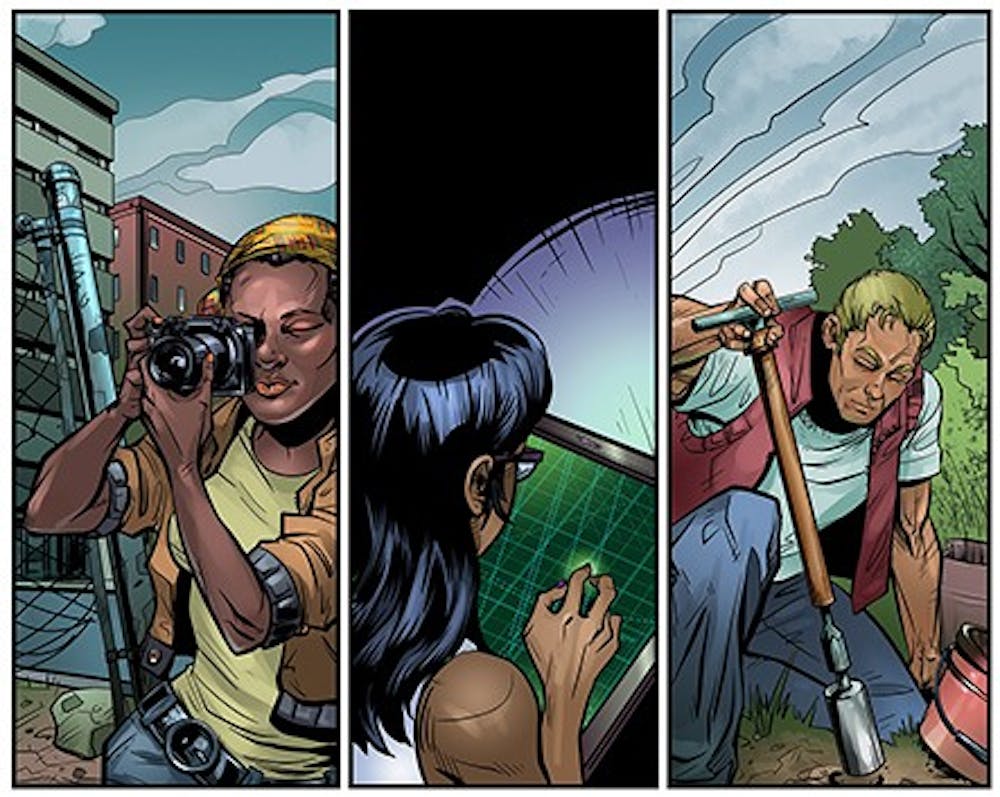Staring down at the ground below, cars and people are the size of ants. They zip past each other completely unaware of a man scaling the building just above their heads. Placing one hand before the other, the man continues to climb up. Only the suction cups on his suit continue to support him. He reminds himself not to look down again and keeps his eyes focused on the target. The goal is to share an idea that just might evoke a change in the world.
“What I like about EVOKE is that it’s an invitation to become a secret agent to change the world; that’s what the graphic novels are about,” founding director of the Center for Science and the Imagination Ed Finn says. “It’s like mission impossible; except the missions they’re taking on are to make the world a better place.”
Originally based on a graphic novel, EVOKE was further developed by the World Bank Institute (WBI). First aimed at teens in Africa, the game’s goal is to foster a sense of social innovation and civic engagement within its users. The game takes players through a series of simulations that solve world issues, such as hunger and education.
Since then, the game has expanded to a variety of countries including Columbia, Mexico and Brazil. Now the Department of Science and Imagination’s "Project Hieroglyph" has been invited to further the developments of the game.
“'Project Hieroglyph' is the flagship research program at the center I run here,” Finn says. “'Hieroglyph' was founded by the writer Neal Stephenson as an effort to get people thinking more creatively and ambitiously about the future, which is also the mission of our center.”
The main focus of "Project Hieroglyph" is to bring together science fiction writers with engineers and scientists to come up with more creative and ambitious plans about the future. Essentially the program unites an author’s idea with a technician who can work to make that idea a reality. "Project Hieroglyph" caught the attention of the WBI.
“The people at the bank who have been working on EVOKE got in touch with us because President Crow had spoken there and they had heard about 'Hieroglyph',” Finn says. “They got in touch with us to see if we would be interested in working with them on future versions of EVOKE.”
Kathryn Cramer, who is the "Project Hieroglyph" co-editor was one of the many from Project Hieroglyph that also worked on EVOKE. As a fiction editor this was Cramer’s first time working in a gaming environment. Her main job throughout the partnership was to help create a story bible for the video game based off of the original EVOKE graphic novels.
“The main inspiration for the story bible was actually the solicitation to the writers for 'Hieroglyph',” Cramer says. “We had a lot of the information about what kinds of ideas we were looking for in positive, technological, optimistic, innovative ideas—that basis was already established. It was much easier writing the guidelines for EVOKE having the ones from 'Hieroglyph' in hand.”
Finn also plans on further developing the stories in EVOKE by holding an event called Narrative Hackathon, Oct. 22 to 24, that will allow invited writers and artists to come up with their own ideas for stories. These narratives have the potential to appear within the next version of the game.
“We’re working with the bank to come up with a set of new stories and missions in the game around a set of themes, which we’re still working at, but will likely include issues like clean water, sustainability, education and a number of other issues like that,” Finn says. “We’re essentially connecting this EVOKE platform that already exists with the community of people involved in 'Hieroglyph'. At the Hackathon we’ll bring together writers, graphic artists, comic book creators, subject matter specialists in a number of topics, futurists and other kinds of facilitators to make the whole process come together.”
The main reason behind the partnership between ASU and the WBI is to further develop the narrative foundation of EVOKE, since the story plays a major role in the main idea of the game. Computer Science junior Eric Tang is President of the Video Game Development club at ASU. The club consists of a group of individuals that are interested in the video game development processes from programming to graphic design. He agrees that while the mechanics of a video game are important, the stories behind the game are just as vital.
“The best games I’ve played I’ve only wanted to play because, whether or not the game mechanics are interesting, I wanted to learn more about the story and how to reach the goal I was given at the beginning,” Tang says. “The best games have the best stories, you can’t escape that.”
While EVOKE may not necessarily contain fancy gadgets or booby traps, the game creators hope players will feel motivated to help better the world.
“What I’m hoping for is a process where they’re (the players) inspired to participate in our story, and help the story move along, and figure out what ought to be done about the problems actually outlined in the story,” Cramer says. “Having that more detailed thought experience in hand, do the kind of innovative work that the initial story was able to evoke.”
For more information on EVOKE please visit http://www.urgentevoke.com/
CORRECTION: Due to a reporting error, a previous version of this article misspelled the name of a person mentioned in the piece. This version has been updated with proper spelling.
Reach the writer at mchavan1@asu.edu or @manalichavan72.





